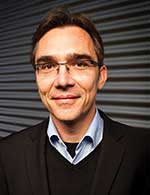JÜRGEN POPP, LEIBNIZ INSTITUTE OF PHOTONIC TECHNOLOGY
Biophotonics has emerged as a vibrant, multidisciplinary field with global impact on biomedical research, and its label-free techniques offer great potential for noninvasive clinical applications. To date, however, very few label-free optical techniques have achieved more than marginal clinical or commercial success, with one major exception being optical coherence tomography (OCT). This lack of success must be overcome.
In a simple model, the development and translation of medical technology has three different stages, of which the first is the design, construction and proof of principle demonstration of a new device. Usually, this is the phase at which technologists and research scientists are heavily involved. The next stage is the engineering development to render the device sufficiently compact, robust and ergonomic for the final stage of clinical trials to demonstrate safety and efficacy.
Before any clinical trials can establish safety and efficacy, it is necessary to obtain regulatory approval. This presents significant logistical and financial challenges that are often beyond the capabilities of academic research groups. Once this hurdle is passed, it is then necessary to show that the new medical technology can be integrated into clinical practice and provide significant benefits to patients and to the clinical team. Finally, a critical requirement for successful translation and commercial success is to gain acceptance by health insurance companies or state health care providers in order to become a standard and reimbursable procedure.
Traditionally, research scientists have mainly been strongly engaged in the initial research stage, for which the main outputs are scientific publications. But many excellent device concepts fail to progress through the development stage to clinical translation. This can be because the academic research groups do not have the engineering and/or financial resources to address the second and third stages of translation, which typically entail the kind of work that does not lead to the kind of recognition required by academic researchers.
Furthermore, new technology is often considered too risky to be taken up by industry or commercial investors, who typically minimize risk in their investments by outsourcing development-related work to research groups or startups. In many cases, approvals for the use of experimental devices in humans involve construction of such devices under design control protocols and compliance with quality assurance practices. Typically, universities are not equipped with quality systems regulations that are good manufacturing practice (GMP) compliant for medical devices or dedicated prototyping areas.
To meet the regulatory hurdles, it is necessary to demonstrate that the new device is safe, but this can be challenging when safety standards for optical radiation still need clarification. Most current optical safety standards have been derived from studies of the exposure of skin and eyes to optical radiation and cannot be blindly applied to internal tissues that are usually not exposed to light. The task of undertaking such safety studies, as well as the engineering development required to make clinically practical instrumentation, is beyond the means of most research groups. If no industry partner can be found, the main route to market would be through a startup company, but many academic researchers are not eager to set aside their academic roles to take this path.
One way to address this situation is to establish “product engineering” teams at universities including professional engineers who can undertake the development and safety testing work. This would avoid burdening the more scientifically oriented personnel like Ph.D. students and post-docs. However, the financing of such teams that are critical for the successful translation of medical technologies presents a major challenge.
In the aftermath of the 2008 financial crisis, the decrease in appetite for risk-taking has made it more difficult to secure the investment needed for clinical translation of new technology. A much more targeted approach should be developed that starts by integrating teams of scientists and clinicians to address specific unmet clinical needs and proactively works with companies interested in promoting the technology at the earliest opportunity.
Such teams need to be supported by appropriate funders to make it through the necessary development phases and clinical trials, and health care providers and insurance companies should be engaged at these earliest opportunities to ensure the clinical use of the evolving instrument will be reimbursable. This close collaboration of all stakeholders should help develop and translate promising new medical technology to the stage where the ultimate goal, the benefit of the patient, is within reach.
 Meet the author
Meet the author
Jürgen Popp is the scientific director of the Leibniz Institute of Photonic Technology in Jena, Germany; email [email protected].
Acknowledgments
The author would like to thank Paul French at the Imperial College in London, Laura Marcu at the University of California/Davis in Davis, Calif., Robert J. Nordstrom at the National Institute of Health in Bethesda, Md., and Brian Wilson at the University of Toronto in Toronto, Ontario, Canada.